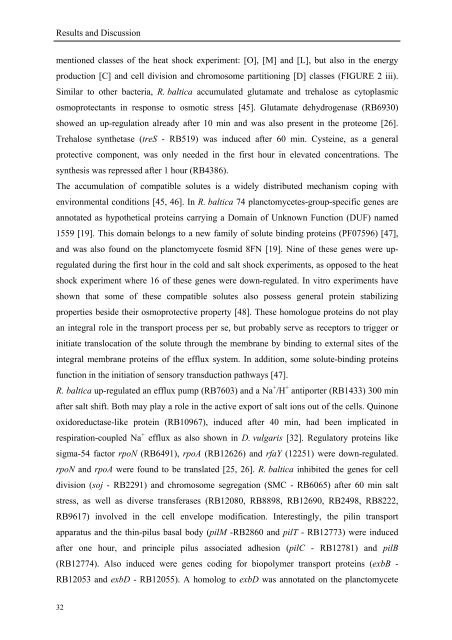a Whole Genome Array Approach - Jacobs University
a Whole Genome Array Approach - Jacobs University
a Whole Genome Array Approach - Jacobs University
You also want an ePaper? Increase the reach of your titles
YUMPU automatically turns print PDFs into web optimized ePapers that Google loves.
Results and Discussion<br />
mentioned classes of the heat shock experiment: [O], [M] and [L], but also in the energy<br />
production [C] and cell division and chromosome partitioning [D] classes (FIGURE 2 iii).<br />
Similar to other bacteria, R. baltica accumulated glutamate and trehalose as cytoplasmic<br />
osmoprotectants in response to osmotic stress [45]. Glutamate dehydrogenase (RB6930)<br />
showed an up-regulation already after 10 min and was also present in the proteome [26].<br />
Trehalose synthetase (treS - RB519) was induced after 60 min. Cysteine, as a general<br />
protective component, was only needed in the first hour in elevated concentrations. The<br />
synthesis was repressed after 1 hour (RB4386).<br />
The accumulation of compatible solutes is a widely distributed mechanism coping with<br />
environmental conditions [45, 46]. In R. baltica 74 planctomycetes-group-specific genes are<br />
annotated as hypothetical proteins carrying a Domain of Unknown Function (DUF) named<br />
1559 [19]. This domain belongs to a new family of solute binding proteins (PF07596) [47],<br />
and was also found on the planctomycete fosmid 8FN [19]. Nine of these genes were upregulated<br />
during the first hour in the cold and salt shock experiments, as opposed to the heat<br />
shock experiment where 16 of these genes were down-regulated. In vitro experiments have<br />
shown that some of these compatible solutes also possess general protein stabilizing<br />
properties beside their osmoprotective property [48]. These homologue proteins do not play<br />
an integral role in the transport process per se, but probably serve as receptors to trigger or<br />
initiate translocation of the solute through the membrane by binding to external sites of the<br />
integral membrane proteins of the efflux system. In addition, some solute-binding proteins<br />
function in the initiation of sensory transduction pathways [47].<br />
R. baltica up-regulated an efflux pump (RB7603) and a Na + /H + antiporter (RB1433) 300 min<br />
after salt shift. Both may play a role in the active export of salt ions out of the cells. Quinone<br />
oxidoreductase-like protein (RB10967), induced after 40 min, had been implicated in<br />
respiration-coupled Na + efflux as also shown in D. vulgaris [32]. Regulatory proteins like<br />
sigma-54 factor rpoN (RB6491), rpoA (RB12626) and rfaY (12251) were down-regulated.<br />
rpoN and rpoA were found to be translated [25, 26]. R. baltica inhibited the genes for cell<br />
division (soj - RB2291) and chromosome segregation (SMC - RB6065) after 60 min salt<br />
stress, as well as diverse transferases (RB12080, RB8898, RB12690, RB2498, RB8222,<br />
RB9617) involved in the cell envelope modification. Interestingly, the pilin transport<br />
apparatus and the thin-pilus basal body (pilM -RB2860 and pilT - RB12773) were induced<br />
after one hour, and principle pilus associated adhesion (pilC - RB12781) and pilB<br />
(RB12774). Also induced were genes coding for biopolymer transport proteins (exbB -<br />
RB12053 and exbD - RB12055). A homolog to exbD was annotated on the planctomycete<br />
32

















